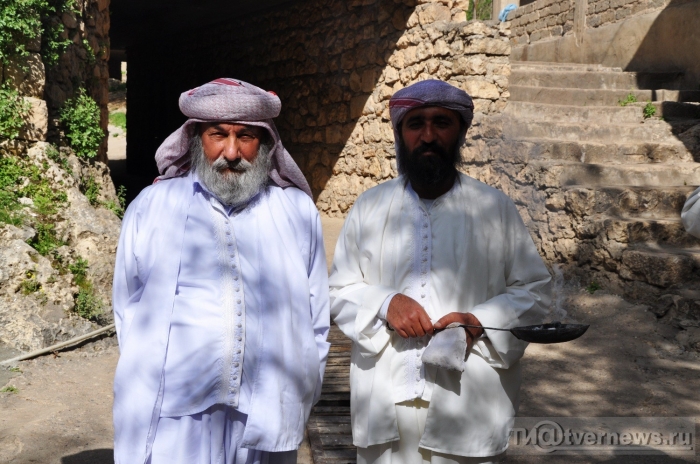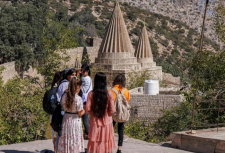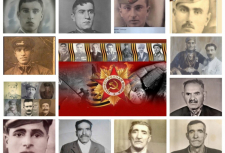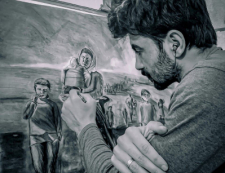Milete min Ezid. The Uniqueness of the Yazidi Concept of the Nation

Artur Rodziewicz Jagiellonian University, Kraków, Poland
The Yazidi millet
To answer the question of whether the Yazidis are an independent nation or a part of another or other nations, one should first of all look at how they define their community when they do not use the terminology of modern Western political science and contemporary political discourse. Unfortunately, the modern scientific approach imposes a specific (secular or even atheistic) way of thinking, which ignores religious perspective which is, in my view, crucial to understanding the essence of the Yazidi community that is strictly connected with their beliefs. Thus it may be helpful to refer to oral tradition, especially to religious hymns and phrases that have remained unchanged for a long time. Given that for long tracts of time the Yazidis were not literate (because of a religious ban on writing), this seems particularly pertinent. One of the most frequent self-declarations of the Yazidis is an enigmatic phrase, the first part of which was mentioned in the title of this paper Milete min Êzîd Dîne min Şerfedîn Its beginning part concerns the millet, while the second deals with religion – dîn. This utterance shows that the Yazidis distinguish the name of their community from the name of their religion. In order to realize how they perceive this community and to address the significance that their millet is Êzîd, one should try at first to understand their perception of the term millet and investigate whether it differs from its colloquial use in the Middle East. Millet, a word of Arabic origin, in modern Kurdish generally means “nation” or “people” (Chyet 2003, p. 387). However, it originally denoted “religion” and “religious community” (Richardson 1777, p. 1834-1835; Ursinus 1993; Braude 2014, p. 65-86), as for example in the Quranic phrase describing the Jews as “the people/religion of Abraham” (“Millat Ibrahim”) or in the Arabic/Persian name for Christians as “the People of the Messiah” (“Al-milla al-Masihiyya”/ “Mellat-e Masihiye”).
This word is present in the oldest Yazidi poetry, especially in the sacred hymns (Qewls) probably dating back to the 12th and 13th centuries, surrounded by great reverence and recited during the main ceremonies (Rodziewicz 2018c). In these works, composed in Kurmanji but also containing a lot of Arabic terms, it is repeatedly mentioned that 72 millets were born from Adam and Eve. I will refer only to two fragments (for other examples, see Rodziewicz 2018a, pp. 280-283) from the group of the most important Yazidi hymns, called Qewlê Beranî (Omarkhali 2017, p. 102). One of them is the Qewlê Zebûnî Meksûr, The Hymn of the Weak Broken One. In stanza 42 (Rodziewicz 2018d) it is stated that: Ji Adem wê bûn coqete, From Adam groups [of people] sprang, Jê vavartin heftê û du milete. Seventy-two nations were separated from him. Similarly in the Qewlê Qere Ferqan, The Hymn of the Black Furqan, stanza 33 (Kreyenbroek, Rashow 2005, p. 100): Min ji Adem vevartibûn heftî û du milete. From Adam, I brought forth the seventy-two nations.
According to the Yazdi belief, they do not belong to this group, because they are a separate race or nation, the progeny of Adam alone, and more precisely his son, Shehid ben Jarr (and a houri named Layla), who was conceived without the participation of Eve (Spät 2002).
The content of the Yazidi myths, which have been in force for centuries, clearly reflects their views about the relationship of their community to other groups. These beliefs are manifested in the strict prohibition of exogamy, entering into marriage with any of these 72 nations. Also, the number of genocides (ranging from 72 to 74) often cited by the Yazidis, originates from this ethnogeny myth and symbolically means that they were victims of all nations/non-Yazidis.
Tags: #yazidisinfo #yezidi #yazidi
Milete min Ezid. The Uniqueness of the Yazidi Concept of the Nation

Artur Rodziewicz Jagiellonian University, Kraków, Poland
The Yazidi millet
To answer the question of whether the Yazidis are an independent nation or a part of another or other nations, one should first of all look at how they define their community when they do not use the terminology of modern Western political science and contemporary political discourse. Unfortunately, the modern scientific approach imposes a specific (secular or even atheistic) way of thinking, which ignores religious perspective which is, in my view, crucial to understanding the essence of the Yazidi community that is strictly connected with their beliefs. Thus it may be helpful to refer to oral tradition, especially to religious hymns and phrases that have remained unchanged for a long time. Given that for long tracts of time the Yazidis were not literate (because of a religious ban on writing), this seems particularly pertinent. One of the most frequent self-declarations of the Yazidis is an enigmatic phrase, the first part of which was mentioned in the title of this paper Milete min Êzîd Dîne min Şerfedîn Its beginning part concerns the millet, while the second deals with religion – dîn. This utterance shows that the Yazidis distinguish the name of their community from the name of their religion. In order to realize how they perceive this community and to address the significance that their millet is Êzîd, one should try at first to understand their perception of the term millet and investigate whether it differs from its colloquial use in the Middle East. Millet, a word of Arabic origin, in modern Kurdish generally means “nation” or “people” (Chyet 2003, p. 387). However, it originally denoted “religion” and “religious community” (Richardson 1777, p. 1834-1835; Ursinus 1993; Braude 2014, p. 65-86), as for example in the Quranic phrase describing the Jews as “the people/religion of Abraham” (“Millat Ibrahim”) or in the Arabic/Persian name for Christians as “the People of the Messiah” (“Al-milla al-Masihiyya”/ “Mellat-e Masihiye”).
This word is present in the oldest Yazidi poetry, especially in the sacred hymns (Qewls) probably dating back to the 12th and 13th centuries, surrounded by great reverence and recited during the main ceremonies (Rodziewicz 2018c). In these works, composed in Kurmanji but also containing a lot of Arabic terms, it is repeatedly mentioned that 72 millets were born from Adam and Eve. I will refer only to two fragments (for other examples, see Rodziewicz 2018a, pp. 280-283) from the group of the most important Yazidi hymns, called Qewlê Beranî (Omarkhali 2017, p. 102). One of them is the Qewlê Zebûnî Meksûr, The Hymn of the Weak Broken One. In stanza 42 (Rodziewicz 2018d) it is stated that: Ji Adem wê bûn coqete, From Adam groups [of people] sprang, Jê vavartin heftê û du milete. Seventy-two nations were separated from him. Similarly in the Qewlê Qere Ferqan, The Hymn of the Black Furqan, stanza 33 (Kreyenbroek, Rashow 2005, p. 100): Min ji Adem vevartibûn heftî û du milete. From Adam, I brought forth the seventy-two nations.
According to the Yazdi belief, they do not belong to this group, because they are a separate race or nation, the progeny of Adam alone, and more precisely his son, Shehid ben Jarr (and a houri named Layla), who was conceived without the participation of Eve (Spät 2002).
The content of the Yazidi myths, which have been in force for centuries, clearly reflects their views about the relationship of their community to other groups. These beliefs are manifested in the strict prohibition of exogamy, entering into marriage with any of these 72 nations. Also, the number of genocides (ranging from 72 to 74) often cited by the Yazidis, originates from this ethnogeny myth and symbolically means that they were victims of all nations/non-Yazidis.
Tags: #yazidisinfo #yezidi #yazidi


























